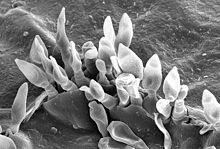Dothideomycetes
| Dothideomycetes | |
|---|---|

| |
| The reproductive conidia of Venturia inaequalis erupting through the cuticle of a crabapple leaf | |
| Scientific classification | |
| Domain: | Eukaryota |
| Kingdom: | Fungi |
| Division: | Ascomycota |
| Subdivision: | Pezizomycotina |
| (unranked): | Leotiomyceta |
| (unranked): | Dothideomyceta
|
| Class: | Dothideomycetes O.E.Erikss. & Winka (1997) |
| Subclasses & orders | |
| |
Dothideomycetes is the largest and most diverse
Wijayawardene et al. in 2020 added more orders to the class.[3]Traditionally, most of its members were included in the
loculoascomycetes, which is not part of the currently accepted classification.[4] This indicates that several traditional morphological features in the class are not unique and DNA sequence comparisons are important to define the class.[5]
The designation loculoascomycetes was first proposed for all fungi which have
DNA sequence comparisons it is now clear that another group of fungi which share these characteristics are distantly related. These are the "black yeasts" in subclass Chaetothyriomycetidae (Eurotiomycetes).[7] This means that loculoascomycetes did not constitute a natural group
.
The best known members of this class are several important
plant pathogens (like Phaeosphaeria nodorum and Venturia inaequalis). However, a majority of described species are either found as endophytes or saprobes growing on woody debris, decaying leaves or dung. A smaller number exist as lichens[8] and a single species, Cenococcum geophilum, can form mycorrhizal associations with plant roots.[9]
See also
References
- ISBN 978-0-85199-826-8.
- PMID 20169021. Archived from the original(PDF) on 2011-09-27. Retrieved 2010-02-04.
- hdl:10481/61998.
- PMID 17572334.
- PMID 18029164.
- ^ Luttrell ES, 1951. Taxonomy of Pyrenomycetes. University of Missouri Studies 24, 1–120.
- PMID 17486980.
- PMID 20169027.
- PMID 8899729.
External links
- Tree of Life Dothideomycetes
- Schoch, Conrad L.; Spatafora, Joseph W.; Lumbsch, H. Thorsten; Huhndorf, Sabine M.; Hyde, Kevin D.; Groenewald, Johannes Z.; Crous, Pedro W. (2009). A phylogenetic re-evaluation of Dothideomycetes (PDF). Studies in Mycology. Vol. 64. CBS-KNAW Fungal Biodiversity Centre. pp. 1–15S10. PMID 20169021. Archived from the original(PDF) on 2017-08-24. Retrieved 2017-08-24.
